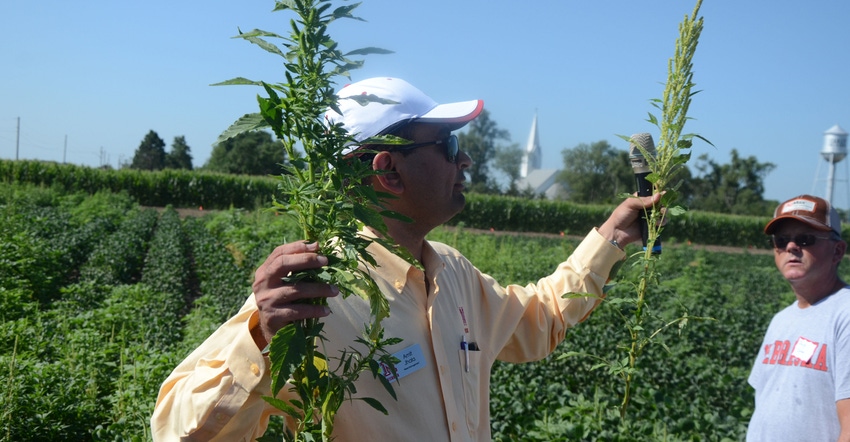
When it comes to telling male and female pigweed species from one another, there is no tail to lift, so to speak. Pigweeds like Palmer amaranth and waterhemp are dioecious species — meaning male and female plants are separate, and female plants require the pollination from male plants to reproduce.
At a recent Glyphosate-Resistant Palmer Amaranth Management Field Day near Carleton, Neb., Amit Jhala, Nebraska Extension weed management specialist, highlighted the differences between male and female Palmer plants.
Before the plants develop inflorescence, it’s more difficult to tell them apart. Research is ongoing for gender analysis in Palmer before flowering stage. Once the inflorescence (the part of the plant that includes the seed head and bracts) emerges, the difference is much more apparent. Many farmers have made the mistake of grabbing a female Palmer plant, realizing too late their mistake when being poked by the prickly stem and bracts on the plant. Meanwhile, male plants are much softer.
“The seed head of the male plant isn’t as prickly compared to female plants. The female plant will be prickly throughout the plant, on the stem as well as on the inflorescence,” Jhala says. “If you go to the field later in the season in September, the female plant will have a longer seed head compared to the male plant. The top portion could be between 1 to 2 feet long.”
Why does this matter? As mentioned before, Palmer amaranth is a dioecious species, and requires male plants to pollinate female plants to make viable seed.
By the time it’s easiest to tell the two apart, it’s too late for any additional chemical control. However, the main goal at that point, if there are any remaining Palmer amaranth plants, is to remove any female plants, manually if necessary.
“Both the male and female plants are equally aggressive. It isn’t important to tell them apart when it comes to chemical control, but it is important if someone wants to walk the field and remove female plants manually, because females are the only plants that will produce seeds. If growers want to be selective and walk the field and remove all the female plants, that could be a good management strategy,” Jhala says.
“If you remove those female plants before they can set seed and before seeds go through the combine, they can’t do much long-term damage,” he says. “It’s more important to remove females to reduce the overall seed bank. If your overall weed seed bank is reduced, then your herbicide program will also be more effective next year.”
About the Author(s)
You May Also Like






